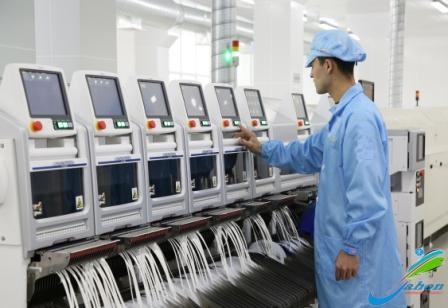Economic results of Uzbekistan in Q2 2016
By egor Monday, 22 August 2016 10:22 AM

I. Deepening structural reforms in the economy and modernizing the country, ensuring macroeconomic balance
Consistent implementation of the most important priorities of economic program for the year 2016, set by the President of the Republic of Uzbekistan Islam Karimov at the session of the government of the Republic on 15 January of the current year, has allowed to preserve sustainable high rates of economic growth of the Republic in the first half the current year.
Compared to the first half of 2015, gross domestic product increased by 7.8%, industry – by 6.7%, agriculture – by 6.8%, retail trade turnover – 14.1%.
Implementation of active investment policy aimed at modernization, technical and technological renewal of production, development of transport and communication infrastructure contributed to the growth of volumes of utilized capital investments by 11.8%, and the contract construction works – by 17.5%.
The establishment of 6.5 thousand objects since the beginning of the year, in the framework of the Programme for development of services for 2016-2020, contributed to the growth of services by 12.9% and their share in GDP from 57.1% in the first half of 2015 to 57.6%.
High rates of economic growth have been achieved while maintaining macroeconomic balance, which in turn contributed to a positive balance of foreign trade turnover, state budget surplus in the amount of 0.1% to GDP and low inflation at 2.5 percent.
The share of manufacturing industries in the structure of industries increased from 77.5% in the same period of 2015 to 78.6%, which provided some 80% growth for the whole industry in the I half of this year.
Qualitative changes in the structure of the industry indicate the effectiveness of the implementation of the Programme of measures on structural reforms, modernization and diversification of production for 2015-2019. In particular, the high growth rate of industrial production was recorded in sectors producing goods based on deep processing of raw materials, including chemical products, rubber and plastic products –129.9%, textiles, apparel and leather products – 116.6%, food – 113.9%, pharmaceutical products and medicines – 124%, building materials – 113.9%.
This resulted in a significant growth of products with high added value, including polyethylene, polypropylene, production of household chemicals, seed drills, centrifugal pumps, finished textile products, medicines and other finished products.
The production of 36 new types and 45 new models of finished sewing and knitting products, 69 new kinds of confectionery products, fruit and vegetable canning products, meat and dairy products, 60 kinds of new drugs have been mastered since the beginning of the year. A 1.3 time growth of loan funds allocated by commercial banks for the purchase of technological equipment and replenishment of working capital of enterprises – manufacturers of consumer products, contributed to the expansion of the range of finished consumer goods.
More than 35 new types of industrial products have been mastered by the enterprises included in the Localization programme, including petrochemical equipment, electric furnaces, electric water heaters, exercise equipment, children's bikes and scooters, speedometers for vehicles and other types of finished products. Overall, localized products worth over 2.3 trillion soums have been produced since the beginning of the year under the Program of localization of production of finished goods, components and materials for 2015-2019. The growth compared to the same period of 2015 made up 1.5 times, the estimated effect of import substitution made up $795 million.
The implementation of active investment policy contributed to the deepening of structural reforms, modernization and diversification of the industry. 43 production facilities with a total value of $ 1.9 billion were commissioned in the first half of the current year in the framework of the Investment program. Among major projects, it is necessary to mention the “Expansion of cement plant in Jizzakh region", "Organization of serial production of passenger cars of model "T-250" at JSC "GM Uzbekistan", "Organization of spinning production at the FE "Indorama Kokand textile" (IV stage)", "Organization of spinning production at "Fanteks” in Bulakbashi district of the Andijan region”, “Construction of Meylisay mine", "Construction of water pipeline and technical water desalination plant at ГМЗ-3", organization of production of polyethylene films and pipes at the JSC "Jizzakh plastmassa", insulation products of glass fibers and a wide range of wiring and electrical products on the territory of Jizzakh FIZ and others. Simultaneously, the implementation of 72 new major investment projects worth over $3.4 billion was launched.
8.9 thousand projects worth over 2.4 trillion soums have been implemented in the framework of territorial programs of socio-economic development of the regions, including 2.6 thousand projects in the sphere of the industry with the introduction of over 2 thousand of new capacities, expansion of capacities of 390 enterprises and modernization of 133 production facilities.
Comprehensive measures to ensure the stability of the financial and banking system contributed to conducting active investment policy. Due to them, the aggregate capital of the banks in the first half of this year increased by 23.3%, their assets by 25.1%, deposits in banks – 27.7%. As a result, the volume of lending to the economy at the expense of the commercial banks increased by 26.2%. At the same time, some 80% of all bank loans were long-term loans for investment purposes.
Out of the total capital investments utilized in the economy during the first half of this year, over 23% were utilized at the expense of foreign investments and loans, whose volume compared to the same period of the previous year grew by 17.2% and amounted to $1.8 billion, with direct foreign investments amounting to $1.2 billion. The volume of funds utilized at the expense of the Fund for reconstruction and development of Uzbekistan towards financing large investment projects in strategic sectors of the economy increased by 6.9% and exceeded $ 240 million.
Over 51% of utilized capital investments accounted for the investments at the expense of own funds of enterprises and population, resulted from the engagement of additional internal resources for the implementation of active investment policy, as well as implementation of measures to stimulate the growth in business revenues and improving living conditions and quality of life of the population.
As a result of implementation of projects on modernization, technical and technological renewal of the industry, as well as the Programme of measures to reduce energy consumption, implement energy saving technologies in industries and the social sector for 2015-2019, the cost of the produced by large enterprises products has been reduced by an average of 9.8%, electricity consumption on average of 265.6 thousand kW.h. per year, GDP energy consumption overall by 7.6%.
 II. Improving the competitiveness of the economy, increasing support to exporters, all-round assistance to farms, small business and private entrepreneurship entities in engaging in exports
II. Improving the competitiveness of the economy, increasing support to exporters, all-round assistance to farms, small business and private entrepreneurship entities in engaging in exports
Consistent implementation of measures on diversification and raising the competitiveness of the industries allowed largely to minimize the impact of the continuing global crisis and negative dynamics of world prices on the country's export potential. As a result, along with the implementation of additional measures to support domestic exporters, in the first half of this year, the volume of exports of goods and services went up by 2.4%.
In order to preserve the positions of domestic exporters on foreign markets, as well as strengthening the export potential of the country, a work was continued to increase the volume of deliveries to foreign markets, diversification of the range and geography of exports, the participation of enterprises in export activities.
About 600 enterprises have been involved in export activities since the beginning of the year, who exported 208 new types of products. The geography of exports has been replenished with 44 new markets. In particular, passenger cars were exported to the UAE and South Africa, power units and engine components to the United Kingdom, webs for wheels to Latvia, oscillators to South Korea, wine goods to Japan, wine-vodka products to the United States and Israel, polyethylene and polypropylene to China, Turkey, South Korea, Latvia, Afghanistan, mineral fertilizers to Sweden, Romania, Bulgaria, Turkey, Indonesia, Moldova, Azerbaijan, molybdenum metal and rhenium to the Netherlands, zinc metal to India and Iran, sports footwear to Belarus, leather goods to Poland and South Korea and others.
Compared to the same period of the previous year, trade volumes of following products has increased: polyethylene - (18.8%), molybdenum products - (2.5 times), suprefos - (1.9 times), ammonium sulfate - (1.3%), trucks - (1.3%), ferrous metals - (1.3%), knitted fabrics - (2.2 times), cotton fabrics - (1.4 times) and other products with high added value.
As a result of implementation of additional measures for promotion of domestic horticultural products for export, including the establishment of a specialized foreign trade company "Uzagroexport”, export volumes of fresh and processed fruit and vegetable products during the first half of this year exceeded 354 thousand tons, or 1.3 times more compared to the same period of 2015, including more than 270 thousand tons of vegetables, more than 130 thousand tons of fruits and grapes, 1.3 million tons of melons.
III. Development and modernization of engineering communications and road transport infrastructure
The first half of this year saw the continuation of the implementation of Programme for development and modernization of engineering communications and road infrastructure for 2015-2019.
In particular, a new electrified railway Angren-PAP (123.1 km length), with a unique tunnel (19.2 km length), connecting the region of the Fergana valley with the rest of the territory of the Republic was commissioned.
Works were carried out on electrification of the railway line Samarkand-Bukhara, on the construction of a railway in the framework of the project "Construction of the railway line Navoi-Konimex-Miskin" and the "Construction of railroads to the Kandym gas processing plant”, on the rehabilitation of 54 km of railways.
As a result of the implementation of the Programme for development of telecommunication technologies, networks and communications infrastructure for 2013-2020, over 1250 km. of fiber-optic broadband networks have been laid. The level of coverage of digital TV has been increased to 68 percent. The number of state information resources reached 318 units, information systems of state bodies exceeded 485 units, 286 types of interactive services have been implemented. More than 677 thousand services with an increase of 2.7 times over the same period of the previous year were rendered during the reporting period through the Single portal.
6 million square meters of housing, including 4.4 million square metres in rural areas and 856.7 km of water supply networks, including 641.6 km in rural areas were introduced in the reporting period in order to further improve the quality of life of the population. More than 5.1 thousand houses have been erected under the Programme on construction of individual housing on standard projects in rural areas.
IV. Advanced development and protection of the interests of private property, entrepreneurship and small business, the progressive reduction of the state share in the economy
In order to further reduce the level of state presence in the economy, 305 state assets were reorganized into private property, with investment liabilities on them amounting to 267.5 billion soums.
In accordance with the approved Program of additional measures on attracting foreign investors in joint stock companies, the state share in the charter fund of 30 companies, amounting to 15% or more were sold to foreign investors. As a result, the number of joint stock companies with state share in the charter fund fell by 1.8%, from 374 to 202 joint-stock companies.
Since the beginning of this year, 361 joint-stock companies started the implementation of the corporate governance code in accordance with the requirements of modern international management methods.
Loans worth 8.3 trillion soums were channeled to support the entrepreneurial activities of small businesses. Hereby the growth against the same period of 2015 amounted to 1.3%. The Fund for financing the preparation of project documentation on investment projects under the Association of banks of Uzbekistan allocated 25 billion soums to finance 31 projects.
Since the beginning of the year, single centers for the provision of public services to business entities on the principle of "one window" has started to function in all districts and cities of the Republic. Over the first half of this year, more than 48 thousands of business entities were rendered public services through "one window" centers.
Due to expanding the access of private entrepreneurship to commodity and raw materials markets, the total number of small business entities accredited at the Uzbek Republican commodity exchange as providers of private goods and services on public procurement has increased by 10.2 percent and reached 40 thousand entities, or 97.7 percent of the total number of participants of public procurement.
Measures on formation of business environment, comprehensive support and further stimulation of small business and private entrepreneurship helped to establish more than 16.4 thousand new small businesses, to increase the share of small business in GDP from 44.7% in the first half of 2015 to 46%, in industry – from 35.5% to 41.9%, in investments from 33.5% to 37.7% and in employment – from 77.3% to 77.7%.
 V. Further deepening reforms and structural changes in agriculture, efficient use of land and water resources
V. Further deepening reforms and structural changes in agriculture, efficient use of land and water resources
The implementation of the program of measures on reforming and development of agriculture for the period 2016-2020 contributed to increase the yield and productivity of crops, expansion of cultivated land for growing fruits and vegetables, modernization of agricultural production. A government order for the production of fruits and vegetables, implemented in the reporting period, provided farmers with a guaranteed sale of a part of their products for state needs and for export.
Optimization of structure of sowing areas resulted in reducing the cotton crops on an area of 30.5 thousand hectares at the expense of the marginal and low-yielding lands. The released from cotton areas were allocated to grow fruit and vegetable cultures through the introduction of new advanced agrotechnologies of cultivation. The number of farms increased by 17.6 thousand and reached 101 thousand.
Construction and reconstruction of 501.4 km of collectors, 137.2 km of closed collector-drainage network, 80 wells of vertical drainage, 432 observation wells, 12 hydraulic structures were completed in the first half of this year. Those facilities contribute to the reclamation and increasing the fertility of agricultural lands.
In the framework of measures on strengthening and development of a material-technical base of storing fruits and vegetables for the period 2016-2020, 57 new refrigerating chambers for storage of fruits and vegetables with a capacity of 27.6 thousand tons were created, 2 refrigerating chambers with a capacity of 250 tons underwent modernization.
Since the beginning of the year, commercial banks allocated loans worth over 296 billion soums to further increase the capacity of the livestock sector, more than 34 thousand projects were implemented on cattle farming, poultry farming, beekeeping and fish breeding.
All above measures resulted in the production of 1.5 million tons of potatoes (109.1% against the same period of 2015), 2.9 million tons of vegetables (109.5%), 176.6 thousand tons of melons (108.3%), 906.7 thousand tons fruits and berries (108%) and 26.6 thousand tons of grapes (109.4%). The total number of cattle exceeded 11.7 million heads (105.6%), production of meat made up 1 008,1 thousand tons (106.8 percent), milk – 4 205,5 (107.1 percent), eggs - 3 065,8 million (109.1%) and others.
VI. Development of the social sphere, further enhancing the level and quality of life of the population
The Programme of creating workplaces and ensuring employment of the population contributed to the creation of 462.5 thousands new jobs in the first half of 2016, including 276.7 thousands new jobs (59.8% of the total) in rural areas.
Appropriate targeted measures were worked out under each region in order to organize practical training and further employment of graduates of professional colleges in the 2015/2016 academic year. At that, a quadripartite treaties "College – enterprise – graduate – hokim" were signed with 468.9 thousand graduates of professional colleges with their consequent attachment to 222 thousands of enterprises and organizations, in order for they could pass an internship with the purpose of further employment.
684.6 billion soums of capital investments (107.1% against the same period of 2015) have been utilized since the beginning of the year in the context of ongoing measures to further improve the quality of education and medical services. Those funds were channeled towards the construction, reconstruction and capital repair of facilities of educational and medical institutions, as well as equipping them with modern equipment. Over 203 billion soums of resources of the Fund for development of children's sport were utilized in the framework of construction and reconstruction of children's sports objects.
As a result, 47 secondary schools with 16.8 seats, 2 schools of music and art, 2 professional colleges with 120 seats, 1 dormitory with 100 seats, 50 sports facilities, medical facilities with 440 beds and 225 visits per shift have been commissioned since the beginning of the year.
VII. Implementation of the State program "Year of a healthy mother and child"
In order to ensure quality and timely implementation of the State program "Year of a healthy mother and child", the I half of this year saw the continue of measures aimed at improving the system of protection of a family, motherhood and childhood, upbringing healthy and harmoniously developed generation, further strengthening the material-technical base of medical institutions, cooperation of public authorities and public organizations in the development of a strong, healthy and happy family.
Work was strengthened and expanded for the medical examination of the youth entering into marriage, a screening survey of pregnant women, vaccination of children against 12 controllable infections.
Over 147 thousand children were sent to children's camps at discount prices. 5 sanatoria-dispensaries of the Republic underwent construction and installation work worth 12.1 billion soums, in order to improve the conditions for rehabilitation and recreation of families, women, children.
More than 4.4 trillion soums and $111 million have been utilized since the beginning of the year in the framework of the State program "Year of a healthy mother and child".
The results of the socio-economic development of the Republic of Uzbekistan for the first half of 2016 indicate that the preservation of sustained high rates of economic growth and macroeconomic balance in the face of continued deep systemic problems in the global economy have been achieved due to consistent and purposeful implementation of a carefully thought out, meeting national interests strategy, recognized worldwide as the "Uzbek model" of development.
The performance and efficiency of the reforms implemented in the Republic are highly appreciated by international financial institutions and the international community, including the heads of states members of the Shanghai Cooperation Organization, including during a high level fifteenth summit held on 23-24 June in Tashkent.
The most important task of ensuring the further increase of the stability of the economy in the coming years is the involvement of internal reserves and to develop additional measures for unconditional implementation of the most important priorities of economic program for 2016, set by the President of the Republic of Uzbekistan Islam Karimov at the session of the government of the Republic on 15 January this year, aimed at the implementation of deep structural reforms in the economy, supporting the development of private property and ensuring the steady growth of entrepreneurial income of the population.
The Ministry of economy of the Republic of Uzbekistan
The State Committee of the Republic of Uzbekistan on statistics




























Add new comment